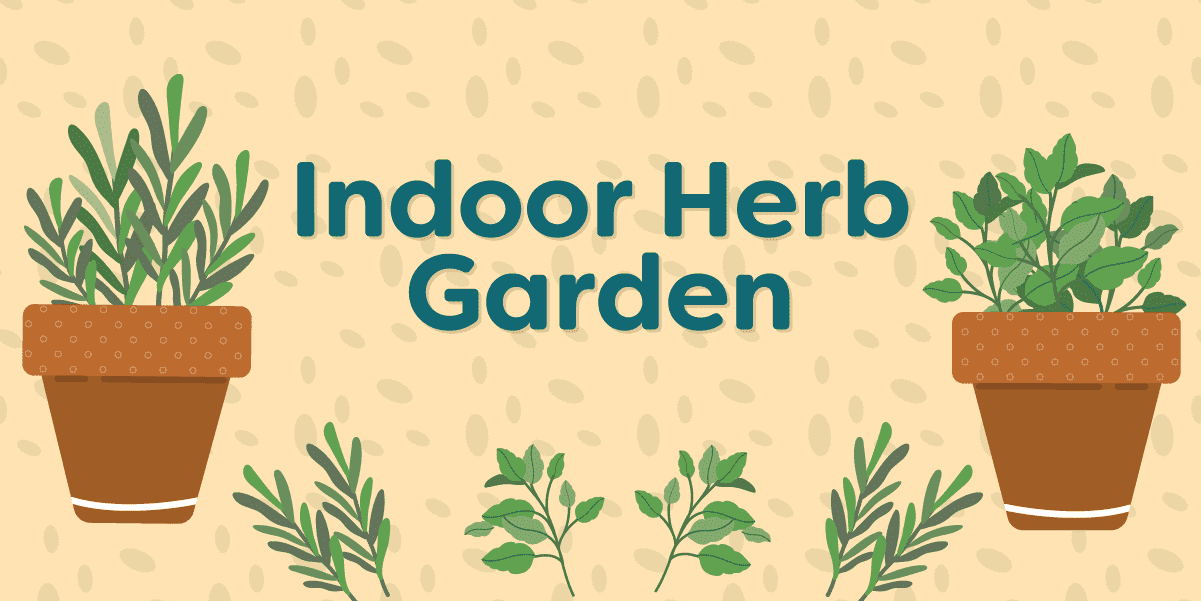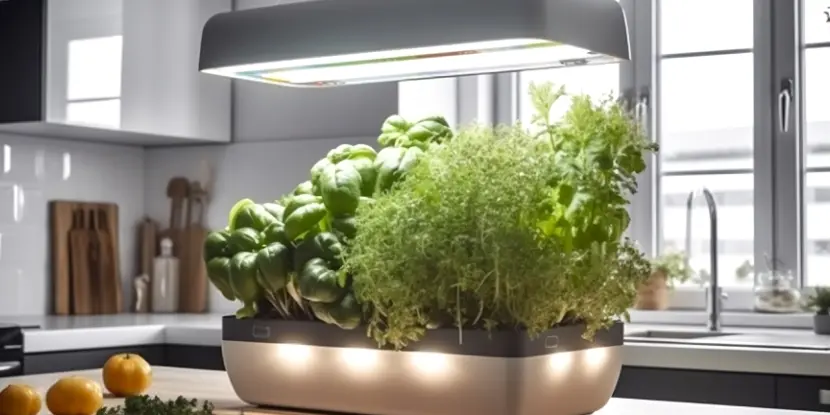An herb garden is one of the easiest gardening projects for beginners — and one of the most rewarding.
You don’t even need to leave the house and step into 95-degree California heat! With the right preparation and equipment, herbs grow just as well indoors as out — in fact, that limp parsley you purchased at Speedy-Mart may have grown hydroponically in a greenhouse and been shipped long-distance to your neighborhood.
While indoor herb gardening isn’t completely set and forget, it’s less strenuous than outdoor gardening, which involves bending, kneeling, and exposure to the elements.
In this blog, we’ll explain how to do it.
What to Grow
You can grow pretty much any herb inside:
- Basil
- Chives
- Lemon Balm
- Marjoram
- Mint
- Oregano
- Thyme
- Parsley
- Cilantro
- Sage
- Rosemary
- Bay Laurel
- Lemon Grass
- Tarragon
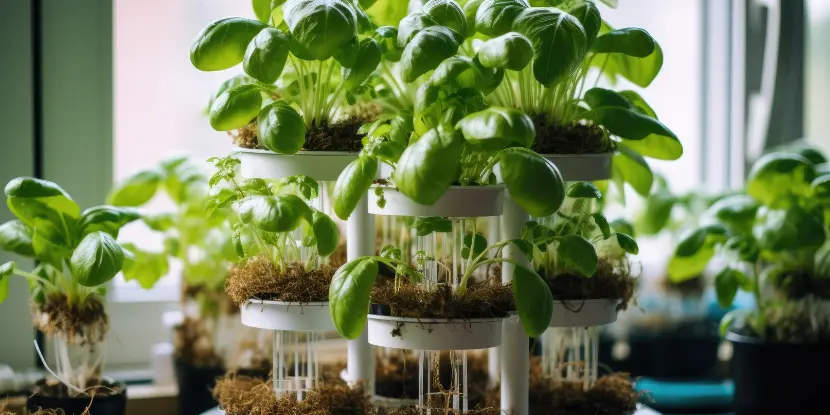
A stacked garden for growing herbs (and saving space).
Light
- Aim for at least 6 hours of direct sunlight per day. South-facing windows typically provide the most natural light.
- If natural light is low, consider installing grow lights. Full-spectrum LED or fluorescent lights are excellent choices and should be placed 6–12 inches above the herbs.
- Rotate the pots regularly to ensure even light distribution and prevent the plants from growing lopsided.
- Most herbs need about 14–16 hours of light per day. Use a timer on grow lights for consistent light exposure.
Temperature
- Most herbs prefer temperatures between 65°F and 75°F (18°C to 24°C).
- To prevent temperature fluctuations, avoid placing herbs near drafts, heating vents, or air conditioning units.
- Ensure nighttime temperatures stay above 55°F (13°C).
- If possible, maintain a consistent temperature. Herbs can be sensitive to abrupt changes.
Choosing Your Container
- All herbs (and plants in general) require drainage for good plant health.
- Make sure the pot has a hole for drainage and a saucer to avoid damaging your surfaces
- In a few months, when roots take up most of the container space, you may need to transplant herbs into a larger pot.
Self-Watering Containers
Self-watering containers can be a game-changer for indoor herb gardening, especially if you have a busy lifestyle or occasionally forget to water your plants.
- Self-watering containers have a built-in reservoir at the bottom, reducing manual watering frequency.
- These containers use capillary action to draw water from the reservoir to the plant’s roots as needed.
- They ensure a consistent moisture level in the soil, which is crucial for the healthy growth of herbs.
- They help prevent overwatering and waterlogging.
- They can maintain plants for several days or weeks without intervention.
- Many models come with water level indicators, making it easy to track reservoir levels.
Soil
- To improve drainage, use a potting mix designed for containers, typically including perlite, vermiculite, and coarse sand.
- Ensure the soil is rich in organic matter. To enhance the potting mix, add compost or a slow-release organic fertilizer.
- The soil should be loose to allow for root growth and aeration. Avoid compacted or heavy soils that can limit root expansion.
- Most herbs prefer slightly acidic to neutral soil, with an ideal pH range between 6.0 and 7.0. Test your soil and adjust with lime to raise pH or sulfur to lower it.
- A sterile potting mix reduces the risk of pests and diseases. Avoid using garden soil, which may contain weed seeds or pathogens.
Growing Herbs Hydroponically from Kits
Hydroponic gardening kits offer a convenient and efficient way to grow herbs indoors without soil.
- Select a kit that fits your space and needs. Popular options include countertop kits and larger vertical systems.
- Follow the manufacturer’s instructions to set up the hydroponic system. This typically involves assembling the frame, attaching the water reservoir, and installing the grow lights.
- Fill the reservoir with water and add the provided nutrient solution. This solution contains all the essential minerals and nutrients needed for herb growth.
- Place the seed pods or plugs into the designated slots. These pods contain seeds embedded in a growing medium, such as rock wool or coconut coir.
- Activate the grow lights and set the timer according to your herbs’ needs. Most hydroponic kits feature full-spectrum LED lights that mimic natural sunlight.
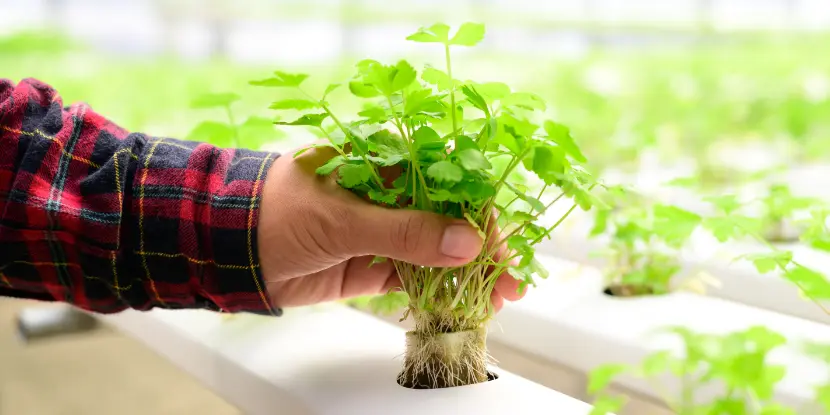
Cilantro growing hydroponically in a greenhouse.
Benefits of Growing Herbs Hydroponically
- Hydroponic systems can fit in small spaces, making them perfect for apartments or homes with limited space.
- Herbs grown hydroponically often reach maturity faster than those grown in soil. The plants receive optimal nutrients and oxygen directly to their roots.
- Hydroponic systems use less water than traditional soil gardening because the water recirculates within the system, reducing waste.
- Growing without soil minimizes the risk of soil-borne pests and diseases.
- Efficient use of nutrients and space yields higher yields than traditional gardening methods.
- Since there’s no soil, there’s no weeding. Woo-hoo!
Growing Herbs Vertically
- A vertical garden is a system where plants grow upwards rather than spread horizontally, using structures like walls, trellises, or specially designed frames.
- These gardens can be created indoors or outdoors, suitable for small spaces like balconies, patios, or even kitchen walls.
- They may include a series of pockets, shelves, or hanging pots to hold the plants, ensuring efficient use of vertical space.
- Modern vertical garden systems may incorporate hydroponics, making them even more adaptable for indoor herb growth.
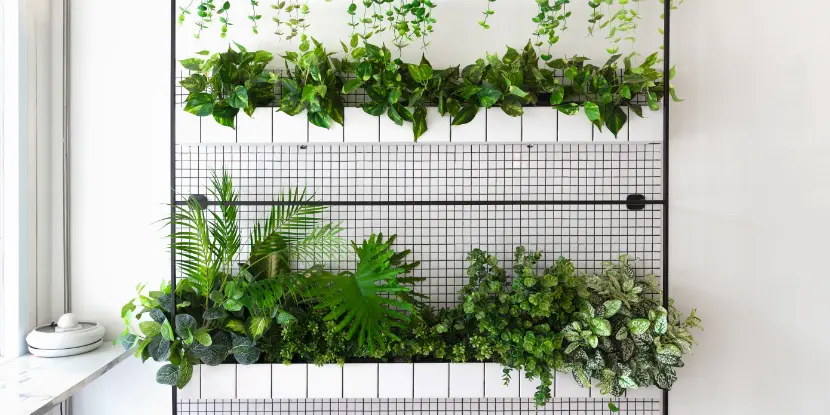
A simple vertical garden with plants mounted on a metal frame.
Why It’s a Good Option for Growing Herbs
- Vertical gardening is ideal for small living spaces or homes without a garden area.
- Vertical gardens add a pleasing, green element to a home.
- Plants are elevated, reducing the need for bending or kneeling.
- Vertical arrangements can enhance airflow around the plants, reducing the risk of disease and pest issues.
- Vertical gardens can be installed on sunny walls, ensuring your herbs get enough sunlight.
- Many vertical gardens have built-in irrigation systems that deliver consistent moisture and nutrients.
Caring for Your Indoor Herbs
- Watering: Water your herbs when the top inch of soil feels dry. Use room-temperature water to avoid shocking the roots.
- Humidity: Dry indoor air can be problematic, especially in winter. Increase humidity by misting your herbs or placing a humidity tray nearby. Grouping plants can help maintain a higher humidity level around them.
- Pruning: Regular pruning prevents herbs from getting too leggy. Use sharp, clean scissors or shears to remove the top 1–2 inches of plant growth.
- Fertilizing: If you don’t use a slow-release fertilizer in your potting mix, you can supplement with a liquid organic fertilizer every two weeks during the growing season.
- Pests and Diseases: Indoor herbs are less susceptible to pests and diseases than outdoor plants. However, regularly inspect your plants for aphids, spider mites, or powdery mildew.
- Repotting: Herbs may outgrow their containers. Repot them into a slightly larger container with fresh potting mix.
- Rotation: Rotate your herbs every few days to ensure even growth and prevent them from leaning towards the light source.
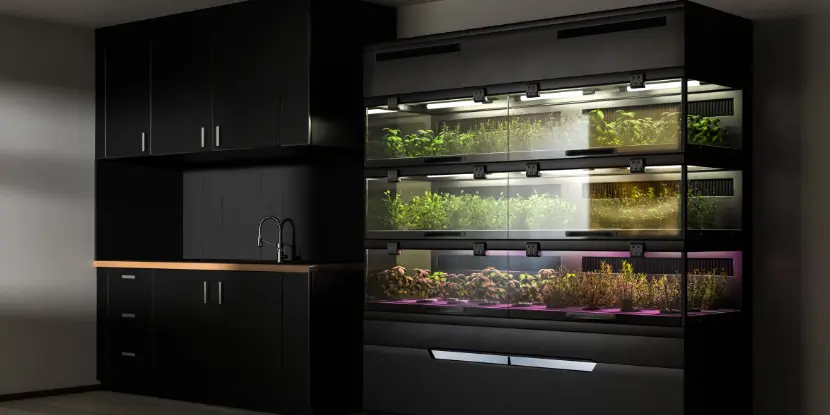
Herbs growing in special cases. Something to aspire to!
Harvesting
- Cut or pinch off herbs’ leaves as needed, leaving some stems behind to encourage new growth. Don’t remove more than a third of the plant at once.
- To prevent herb waste, avoid harvesting more than you can use at once. Consider drying or freezing any excess for later use.
- Some herbs, like basil and mint, benefit from regular pruning, encouraging bushy growth.
Interested in more gardening tips? Please follow Anwalt Lumber & Garden Center on Instagram.
FAQs: Indoor Herb Gardening
Q: How do I prevent my indoor herbs from becoming leggy and weak?
Ensure that your herbs receive adequate light. Place them near a bright window with at least 6–8 hours of sunlight daily, or use full-spectrum grow lights. Regularly rotating your plants helps them grow evenly. Pruning the top 1–2 inches of growth promotes bushier, healthier plants.
Q: What’s the best way to provide consistent moisture for my indoor herb garden?
Water your plants when the top inch of soil feels dry, ensuring thorough watering until it drains from the pot’s bottom. To maintain humidity, regularly mist your herbs, place a humidity tray nearby, or use a room humidifier, especially during dry winter. Grouping your plants can help create a humid microenvironment around them.
Q: Can I grow herbs indoors year-round?
Yes, if you provide the necessary light, temperature, and humidity conditions. Using full-spectrum grow lights and keeping your home environment conducive to plant growth will help your herbs thrive regardless of the season.
Q: Do my indoor herbs need fertilizing, and how often?
Yes, especially in a hydroponic system. For soil-grown herbs, use a liquid organic fertilizer once every two weeks during the growing season. Hydroponic herb kits usually come with nutrient solutions.
Q: How can I prevent pests on my indoor herbs?
Regularly inspect your herbs for aphids, spider mites, and fungus gnats. If you spot any pests, isolate the affected plant and use natural pest control methods like insecticidal soaps or neem oil. Ensure proper air circulation and avoid overwatering, which can create a breeding ground for pests.
Q: What herbs are best suited for indoor growing?
Many herbs do well indoors, but some of the best include basil, mint, parsley, chives, rosemary, and thyme. These herbs adapt well to pot culture.
Q: How can I be sure my indoor herb garden receives enough light during winter?
To supplement sunlight, use full-spectrum grow lights. Place the lights about 6–12 inches above the plants and set them on a timer for 12–16 hours a day to mimic the longer daylight conditions of summer.
Q: Can I use kitchen scraps to fertilize my indoor herbs?
Kitchen scraps like vegetable peels, coffee grounds, and eggshells can be used to create compost or as a direct fertilizer for indoor herbs. Use them sparingly and verify they’ve adequately decomposed to avoid attracting pests.

